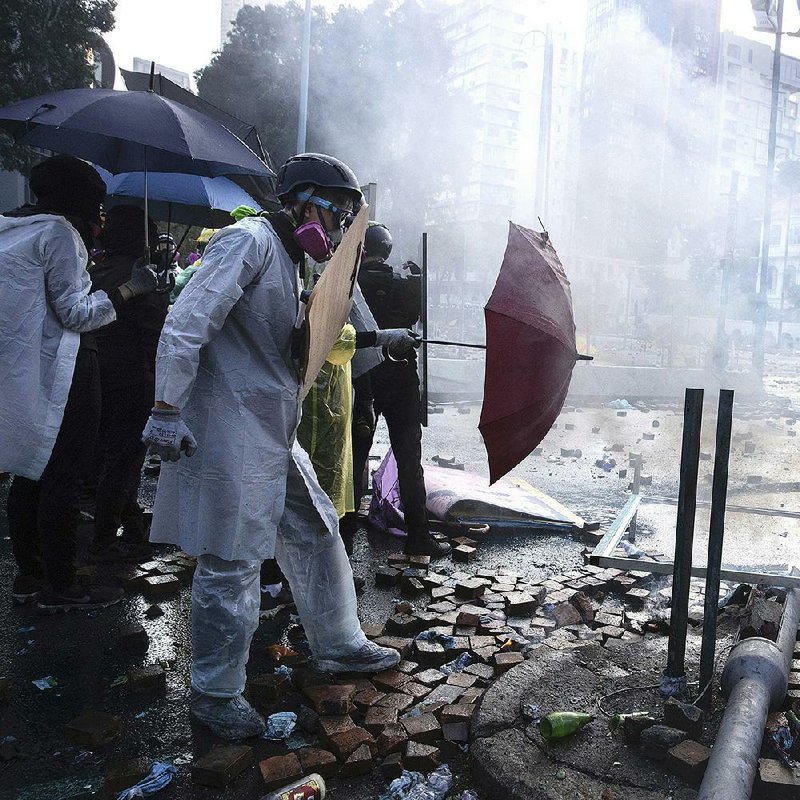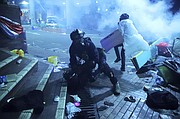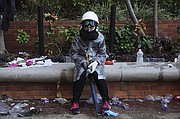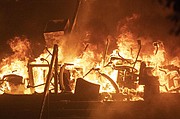HONG KONG -- Police early today breached a Hong Kong university campus held by protesters after an all-night siege that included firing barrages of tear gas and water cannons.
Anti-government protesters have barricaded themselves inside Hong Kong Polytechnic University for days. Police surrounded the area Sunday night and began moving in after issuing an ultimatum for people to leave the area. Protesters wore raincoats and carried umbrellas to shield themselves.
Riot officers broke in through one entrance before dawn as fires burned inside and outside the school, but the police didn't appear to get very far. Fiery explosions could be seen as protesters responded with gasoline bombs.
Police, who have warned that everyone in the area could be charged with rioting, reportedly made a handful of arrests.
But at daybreak, protesters remained in control of most of the campus. In one outdoor area, some demonstrators made gasoline bombs as others dozed while wearing gas masks. Two walked about with bows and quivers of arrows, while many stared at their smartphones.
A lull settled on the area as the president of the university said in a video message that police had agreed to suspend their use of force.
[Video not showing up above? Click here to watch » https://www.youtube.com/watch?D_ZbOXmYmkM]
In the message released this morning, Hong Kong Polytechnic University President Teng Jin-Guang said he had negotiated with police through the night to reach an agreement: Officers would refrain from using force if protesters did not instigate clashes.
"We have now received the assurance of police of a temporary suspension of the use of force under the condition that if the protesters do not initiate the use of force, the police will not initiate the use of force," Teng said. He added that he would personally accompany protesters who left the campus peacefully to the police station to ensure that they would be treated fairly.
It seemed unlikely the protesters would accept the offer given that they would all likely be arrested.
A few hundred streamed out of the campus about 8:15 a.m. in an apparent bid to escape, but they were driven back by tear gas. Some wearing gas masks picked up the smoking tear gas canisters and dropped them into heavy-duty bags, but the protesters decided to retreat as a phalanx of officers lined up across the road in the distance.
Earlier, as police had tried to move in on the campus, they warned of the possibility that stronger measures could follow.
"We will use the minimal force," police said in a Facebook video. "We are asking the rioters to stop assaulting the police using cars, gas bombs and bows and arrows. Otherwise we will use force, including live rounds."
In a video widely shared on social media, a protester in a raincoat and a full-face respirator said he would stay at the university "until the end."
"What will happen to [the students] if we leave?" he asked. "I am so afraid, but I have no choice."
Outside the campus, pro-democracy lawmakers, a top Roman Catholic official, a U.S. pastor and a student leader called for the Hong Kong government to intervene to prevent bloodshed.
"I want to seek help from the government to stop the police force from their operation and avoid tragedy," said Owan Li, a student representative on the university council.
As the police fired tear gas, Bishop Joseph Ha tried to enter with the lawmakers and the U.S. pastor, William Devlin of New York City, but were turned away by the police.
"If the police are to launch a clearance, they should use as minimal force as possible because lives are precious," Ha said.
Devlin said in a telephone interview that he had been on campus for about four hours as the clashes unfolded and had left, adding that he was trying to reenter.
"They were not being deterred," he said of the protesters. "They were ready to be arrested. They said, 'We stand for freedom, dignity, democracy, human rights.'"
[GALLERY: Hong Kong activists, riot police battle » arkansasonline.com/1118hongkong/]
VIOLENCE ESCALATES
As the police closed in on Sunday, protesters used bows and arrows, and one arrow struck a media liaison officer in the calf. Photos on the Police Department's Facebook page show the arrow sticking out of the back of the officer's leg through his pants.
As riot police moved in from all sides, some protesters retreated inside the university. Others set fires on bridges leading to it.
A fire burned along much of a long footbridge that connects a train station to the campus over the approach to the Cross-Harbor Tunnel, a major road under Hong Kong's harbor that has been blocked by protesters for days.
The use of bows and arrows and gasoline bombs marked a sharp escalation of violence by the protesters, who are trying to keep the pressure on Hong Kong leaders who have rejected most of their demands.
The protests started peacefully in early June, sparked by proposed legislation that would have allowed criminal suspects to be extradited to mainland China. But by the time the bill was withdrawn, the protests had broadened into a resistance movement against the territory's government and Beijing.
Activists see the extradition bill as an example of Hong Kong's eroding autonomy under Chinese rule since the 1997 handover from Britain.
Several hundred people formed a human chain Sunday in central Hong Kong in a peaceful rally in support of the movement.
Azaze Chung, a university student, said the government should respond to the protesters' demands, not just use force against them.
Police and protesters faced off all day outside Polytechnic after a pitched battle the previous night in which the two sides exchanged tear gas and gasoline bombs that left fires blazing in the street.
A large group of people arrived Sunday morning to try to clean up the road but were warned away by protesters. Riot police shot several volleys of tear gas at the protesters, who sheltered behind a wall of umbrellas and threw gasoline bombs into nearby bushes and trees, setting them on fire.
The protesters held their ground for most of the day, as water-cannon trucks drove over bricks and nails strewn by demonstrators. The trucks sprayed the protesters at close range -- some with water dyed blue to help police identify the protesters afterward.
Protesters began retreating into the university near sunset, fearing they would be trapped as police approached from other directions. The protesters barricaded the entrances to the campus and set up narrow access-control points.
The protesters are the holdouts from larger groups that occupied several major campuses for much of last week.
Elsewhere, another group threw bricks into the street to block a main thoroughfare in the Mongkok district, as police fired tear gas to try to disperse them. The disruption to traffic may have been an attempt to distract police during the standoff at Polytechnic.
On Saturday, members of the Chinese People's Liberation Army left their barracks to help clear the roadblocks that protesters had erected around universities. It was the People's Liberation Army's first appearance on the streets of Hong Kong since the pro-democracy protests began in June.
As a semi-autonomous territory, Hong Kong is legally distinct from mainland China. Although the army's presence there was not unprecedented -- it also appeared in September 2018 to assist with disaster relief after a severe hit from Typhoon Mangkhut -- the move was seen as a subtle but significant development. Under Hong Kong law, the People's Liberation Army may not interfere in local affairs unless invited by the Hong Kong government.
On Saturday, the Hong Kong government denied that it had invited the People's Liberation Army to clear the roadblocks, saying the work was a "voluntary community activity," according to the Chinese state-owned CGTN. The development drew sharp criticism from pro-democracy lawmakers in Hong Kong, who said it was illegal and a public relations stunt by Beijing to normalize the army's presence in the territory.
Hong Kong's Education Bureau announced that classes from kindergarten to high school would be suspended again today because of safety concerns. Classes have been canceled since Thursday, after the bureau came under criticism for not doing so earlier.
Information for this article was contributed by Ken Moritsugu and Dake Kang of The Associated Press; by Edward Wong, Mike Ives, Tiffany May and Katherine Li of The New York Times; and by Casey Quackenbush, Anna Kam, Shibani Mahtani, Tiffany Liang and Timothy McLaughlin of The Washington Post.
A Section on 11/18/2019



